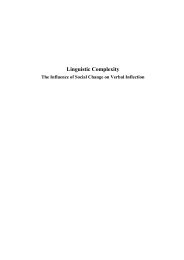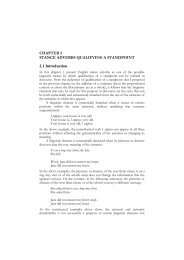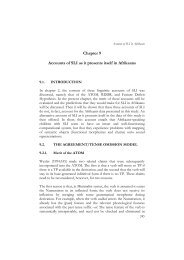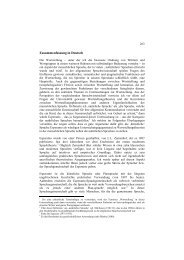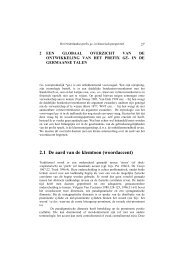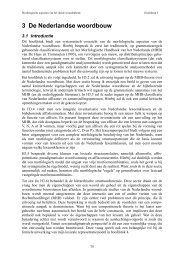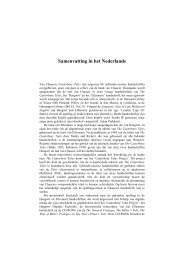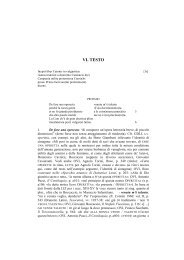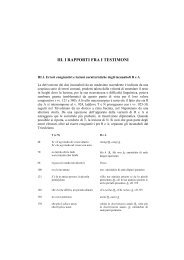Chapter 8: Other Verb-Phrase Operations - LOT publications
Chapter 8: Other Verb-Phrase Operations - LOT publications
Chapter 8: Other Verb-Phrase Operations - LOT publications
You also want an ePaper? Increase the reach of your titles
YUMPU automatically turns print PDFs into web optimized ePapers that Google loves.
194 A Grammar of Mualang<br />
(8-43) Ka’ kikay, di’?<br />
FUT to.where 2s.fem<br />
‘Where are you going?’<br />
8.4.2 Aspect<br />
Comrie (1981:3) gives a general definition for aspect as “different ways of viewing<br />
the internal temporal constituentcy of a situation.” A similar definition is provided<br />
by Payne (1997:238): “aspect describes the internal temporal shape of events or<br />
states.” In Mualang, aspectual meanings are expressed analytically by means of<br />
auxiliaries, or they can be deduced from the context. A discussion of aspectual<br />
auxiliaries is given here:<br />
a. Perfect aspect: nyaw, udah ‘already’<br />
Both nyaw and udah express perfect aspect. In certain contexts they are translatable<br />
as ‘already’. In many constexts their meanings overlap and they may be used<br />
interchangeably, hence the difference between them is subtle. 3 Udah (phonologically<br />
reduced to dah) also has developed into an illocutionary marker (see 9.4 in <strong>Chapter</strong><br />
9). In the construction udah ia’ ‘after that’ which functions as a kind of conjunction<br />
(see section 10.6.1.4) udah cannot be replaced by nyaw. As a perfect auxiliary, udah<br />
emphasizes the accomplishment of an event while it also makes a contrast between<br />
the state of affairs “before” and “after”. Nyaw does not seem to imply such a change<br />
in the state of affairs; it simply refers to something that has happened, e.g.:<br />
(8-44) Ia N-peda’ urang tuay, buk nyaw putih.<br />
3s ACT-see person old hair already white<br />
‘He saw (met) an old person, her hair was already grey.’<br />
(8-45) Ia N-peda’ urang tuay ia’ agi’, buk udah putih.<br />
3s ACT-see person old that again hair already white<br />
‘He saw (met) that old person again, her hair had turned grey<br />
(compared to the last time he saw her).’<br />
In (8-46) the use of nyaw again merely presents a statement about what has<br />
happened, but udah in (8-47) implies the speaker’s deliberate accomplishment of the<br />
activity (he wanted to do something and he did it already):<br />
(8-46) Antu nyaw N-dinga gu’ Apay Aluy.<br />
ghost PERF ACT-hear sound father A<br />
‘(Beyond Aluy’s father’s expectation) the ghost has heard father of<br />
Aluy’s father’s voice.’<br />
3 To some extent the similarity between nyaw and udah may be comparable to Indonesian<br />
telah and sudah. See, for example, Minde and Tjia (2002), for a discussion about the latter and<br />
related matter in Ambonese Malay.



